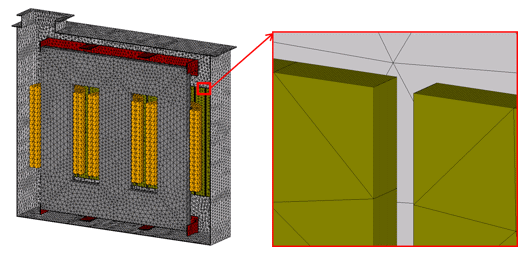Contents
1. Introduction
2. Stray Loss Analysis of a Transformer Using the Homogenization Method
3. Conclusion
1. Introduction
For power transformers, stray loss generated in the surrounding structures due to leakage flux originating from windings is a common issue. Because people may make direct physical contact with the tank, measures have been taken, such as placing a shied inside the tank. Because shields often use magnetic materials such as electromagnetic steel sheets, leakage flux primarily passes through the shield as a magnetic path. This results in magnetic flux linking to the tank being suppressed, and not only heat in the tank drastically reduced, but it can be expected that all stray loss including the shield is reduced.
This leads to the following question: quantitatively, to what extent does the shield have an effect on loss reduction? For stray loss generated in the entire transformer, evaluations can be performed by taking physical measurements, but loss evaluations for each part, such as tank stray loss reduction depending on if there is a shield or not and loss occurrences in the shield, require an evaluation using a magnetic field simulation based on the finite element analysis (FEA). The primary cause of losses resides in the leakage flux that is difficult to examine in advance, which makes simulations even more necessary. FEA-based electromagnetic field simulations realizes a high accuracy analysis using a mesh model to model the object as it is and applying a Maxwell equation.
FEA-based electromagnetic field simulations can be performed with as much detail as needed by raising the detail level of the model. However, the shield inside the transformer has a thin lamination structure when electromagnetic steel sheets are used. Calculating the mesh model accounting for the degree of freedom inside the steel sheet is no longer realistic, when considering the aspect ratio with the size of the entire transformer. This requires some sort of approximation method.
In this paper, each electromagnetic steel sheet of the shield is not modeled; by applying the homogenization method which replaces magnetically and electrically equivalent materials, a realistic mesh model is proposed and an analysis was performed, which is reported below.
Key Technology
- Material Modeling
When the homogenization method is applied to an electromagnetic steel sheet, effective values different from the original values must be specified for magnetic properties and electric properties. JMAG allows the steel sheet lamination factor and the anisotropy of electric resistivity to be specified, allowing easy material modeling with the homogenization method applied. - Mesh Generation
A transformer can be composed of not only the shield, but also many other thin sheet structures such as the tank and clamp. A simulation requires generating mesh accounting for eddy currents in thin geometry, but JMAG’s automatic mesh function can generate mesh that suitable for these types of structures. - Parallel Computing
Because power transformers are composed of several parts, the size of the model tends to increase, and number of elements often becomes more than millions. JMAG’s parallel computing functions makes high-speed simulations achievable for large models such as these.
2. Stray Loss Analysis of a Transformer Using the Homogenization Method
2-1. Searching for Electric Resistivity Used in the Homogenization Method
Applying the homogenization method to an eddy current loss simulation of a shield requires obtaining effective electric resistivity for the shield. Obtaining effective electrical resistivity requires a reference which precisely models the shield, but due to the size of the transformer accompanying huge number of elements, it cannot be obtained with the original scale.
 Mesh for the power transformer model and enlarged shield
Mesh for the power transformer model and enlarged shield
You need to sign in as a Regular JMAG Software User (paid user) or JMAG WEB MEMBER (free membership).
By registering as a JMAG WEB MEMBER, you can browse technical materials and other member-only contents for free.
If you are not registered, click the “Create an Account” button.
Create an Account Sign in



